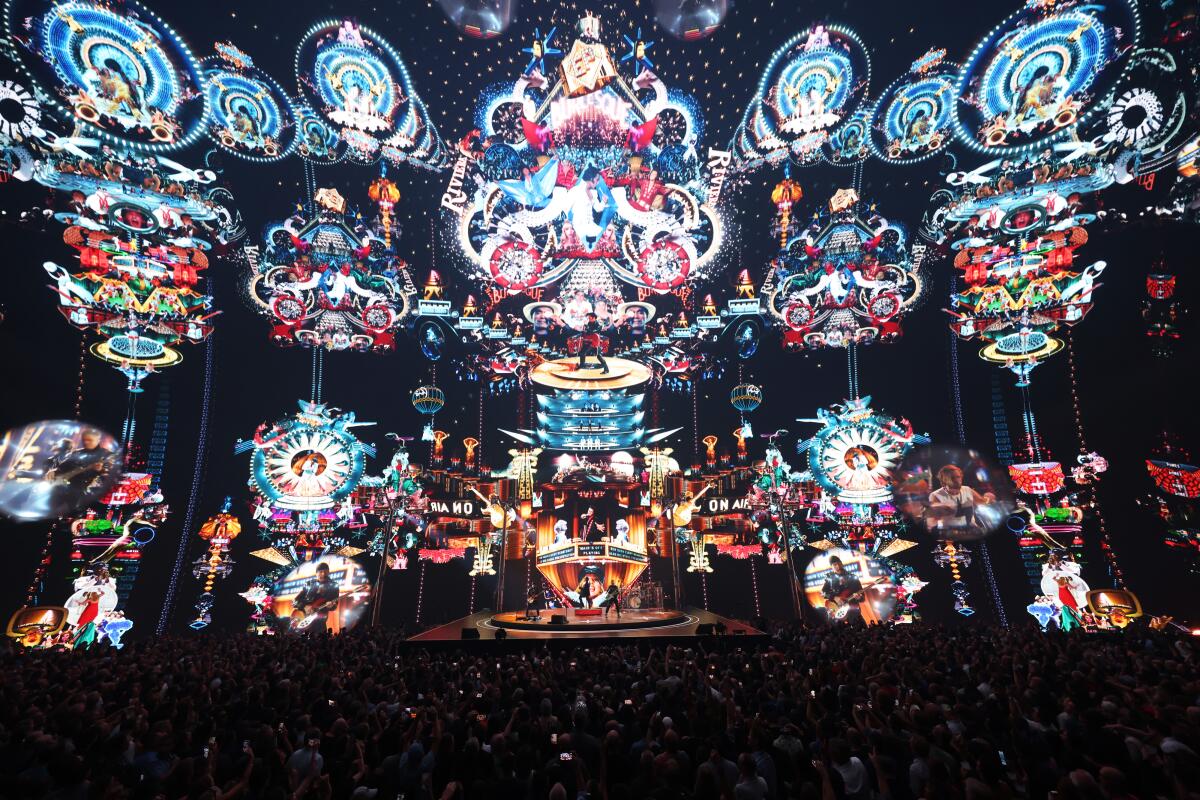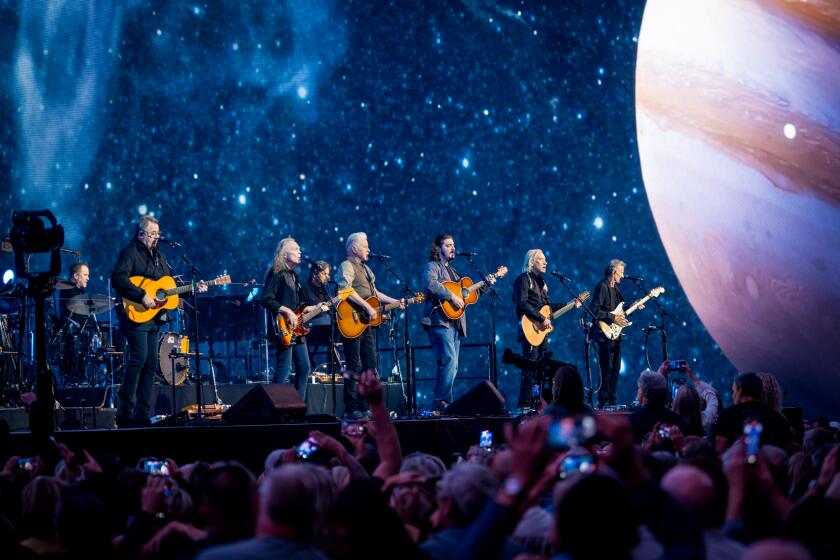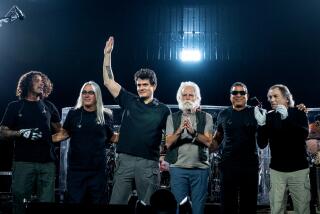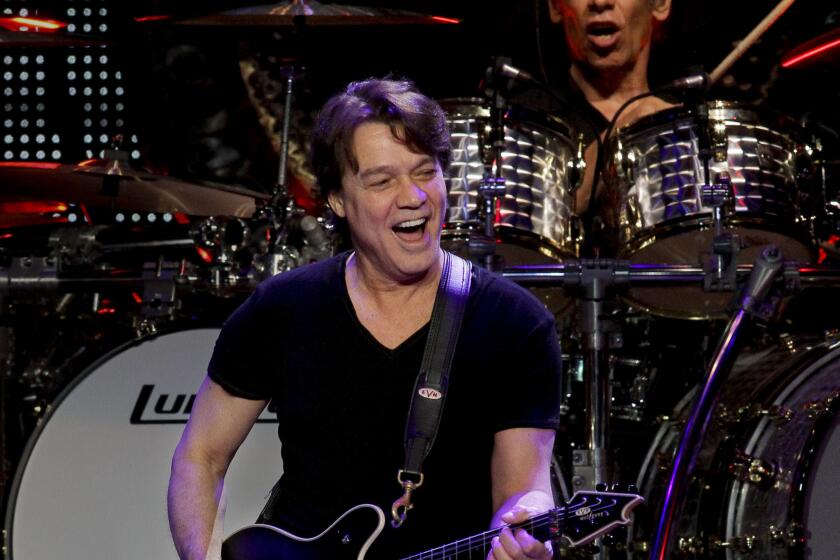U2 made a concert movie of its Sphere show. Sphere is the only place you can see it

- Share via
Nine months after U2 wrapped its 40-date residency at Sphere, the veteran Irish rock band is back at the dome-shaped venue just off the Las Vegas Strip.
Well, sort of.
“V-U2” is a new concert movie that documents the group’s high-tech “U2:UV” show, in which singer Bono, guitarist the Edge, bassist Adam Clayton and drummer Bram van den Berg (filling in for Larry Mullen Jr.) revisited U2’s media-obsessed 1991 album “Achtung Baby” as they inaugurated the $2-billion building outfitted with the world’s highest-resolution LED screen. U2’s stay at Sphere was a critical and commercial success, blanketing social media with eye-popping video clips and raking in nearly $250 million, according to the trade journal Pollstar — and at a moment when the show’s stiff competition included Taylor Swift’s Eras tour and Beyoncé’s Renaissance tour.
So it’s no wonder that U2 followed Swift and Beyoncé in bringing its show to the screen. Unlike those pop superstars’ films, though, this one you can see only at the place where the band filmed it — at Sphere, that is, where “V-U2” plays on that massive wraparound screen on nights when the Eagles aren’t there for their residency. (Between U2 and the Eagles came gigs at Sphere by Phish and Dead & Company.) Directed by the Edge and his wife, Morleigh Steinberg, “V-U2” opened in September and was just extended through the end of February; tickets to see the movie are pricey, starting at around 100 bucks a pop.
Over the weekend, the long-running L.A. country-rock band opened a 20-date residency at the state-of-the-art venue just off the Las Vegas Strip.
Looking back at “U2:UV,” the Edge, 63, says a Sphere production is “its own distinct kind of art form — a new art form, I think, not just for music but for narrative film, for documentary, for all kinds of presentations. It’s the ability to translocate the audience to a new place, be it real or imaginary.” (Among the vignettes in U2’s show were ones that put the crowd in a pre-Strip desert landscape and amid a menagerie of endangered wildlife species.) “You can’t divorce the scale of the imagery from what you might want to do with it,” the Edge adds. As inspirations, the guitarist cites Christo and Jean-Claude’s 2021 wrapping of Paris’ Arc de Triomphe as well as Culver City’s Museum of Jurassic Technology, which he calls one of his favorite places in Los Angeles.
“All those tiny miniatures that fit on the head of a needle — I think it’s so beautiful,” he says in a Zoom call from his place in Malibu. “Again, it’s the scale that makes it unique.”
I get the desire to preserve an ambitious live show for posterity. And I get the impulse to sell tickets to folks who didn’t pay to catch the show in person. What was the creative opportunity you saw in making this movie?
You’ve got to understand that there was a huge amount of risk associated with signing on to be the first band [to play Sphere]. It’s all untried and untested technology, and the building — when we first went to see it, it was half-built, OK? So opening night arrives and we literally walk onstage, no idea if it’s going to work. It’s kind of a white-knuckle ride. Coming out of the first few shows, we realized that not only is it working, it’s like all our ideas have landed. That was such a relief.
Then we pivot quite quickly to the thought of filming it, and what does that mean? We go through a process of consideration and elimination as we realize the show is so bespoke to this venue that to try and capture it for a small screen just wouldn’t make any sense. So then we start thinking, Well, what about capturing it for the screen it happens to be on right now? What was here in potential was an immersive experience — maybe the first of its kind — where you can faithfully represent your live performance so that there’s only a few giveaways that it’s not actually happening live in front of you. That was the thrilling proposition.

The goal was to get an audience member to buy the illusion that U2 is onstage.
Yes. The combination of visuals and the audio and the haptics of the seats — all of those things were brought to bear to try and basically turn on its head the whole idea of suspension of disbelief, so that you’re having to remind yourself that it’s not real, as opposed to pretending that it is.
There’s something very U2 about a concert film that you can see only in the place where the concert happened.
I’d love if [media theorist] Marshall McLuhan could see it. What would he think? Since the beginning of touring “Achtung Baby,” we were riffing on this idea of “even better than the real thing.” That wasn’t lost on us. And I have to say: Finally getting to see U2 live was genuinely shocking. It gave me goosebumps. We’re not half-bad.
The first few songs are shot from a steady position in the audience. Then the camera starts moving around.
You don’t want to give that up too soon. You want people to enjoy the show as it was first designed and imagined. Then you give them a tab of acid and it goes in a completely different direction. We wait until “One,” our fifth song [in the set] — that was a good moment to start deconstructing the show to some extent.
The musician and former Police frontman talks about his life and career ahead of a five-night stand at the Wiltern in Los Angeles.
A good moment in an emotional sense?
I think that’s always the leading metric for us — the emotional connection. We had [director] Mark Pellington come in, and he was the one who suggested the close-up of Bono in “One,” which was a great call. It breaks the movie out of the conceit of it actually being a live show, and suddenly you shatter the fourth wall.
That close-up of Bono is startling to behold.
I haven’t actually had it measured, but it must be the size of a building.
Did Bono get to approve such a revealing shot of his own face?
Oh, yeah [laughs]. His word to us was: “It can’t be just spectacle — you’ve got to capture the humanity of what’s happening.” So, like, mistakes: Bono stumbled over some of his banter in the introductions, and he wanted to keep that in. This is not overly polished.

My instinct is to scoff at that idea. The whole point of Sphere is polish! But there actually is something kind of raw about the movie.
Part of that is practical. With modern post-production, it’s super simple to alter 35-mill format. But since this is such a massive amount of data, to really do anything too fancy would take months and an eye-watering amount of computer processing to achieve. I’m sure future projects will be able to make that possible. But for us, it was kind of straightforward. We knew there wasn’t an awful lot we could do beyond just make cuts and showcase the moments that we thought were the best representations of the show.
Does this movie pose a threat to live music in any way? You think about this or you think about ABBA’s hologram show in London — both enable bands to offer fans a concert-like experience without having to be there in person.
I don’t see it as a threat — no more of a threat than any concert film. The ABBA thing, which I’ve seen, was really fun, given the fact that no one’s seen ABBA perform in the flesh for generations. But I don’t think any of this negates what exists in live concerts — it’s in addition to those offerings.
How did the Sphere experience shape U2’s live ambitions going forward?
I wouldn’t rule out doing something for the Sphere in the future. But we’re itching to get back to regular concerts. Next thing we have to do is a new record, of course. This project was a celebration of “Achtung Baby,” so we’re anxious to do something that’s about new work. We’re already actively developing new material for what will become a U2 album in the future, and we’ll be back to touring. As much as we loved being able to rely on the sound being great every night, there’s a great momentum to being on the road. And seeing local fans, as opposed to relying on them coming to us — it’s different. We miss it.
More to Read
The biggest entertainment stories
Get our big stories about Hollywood, film, television, music, arts, culture and more right in your inbox as soon as they publish.
You may occasionally receive promotional content from the Los Angeles Times.













